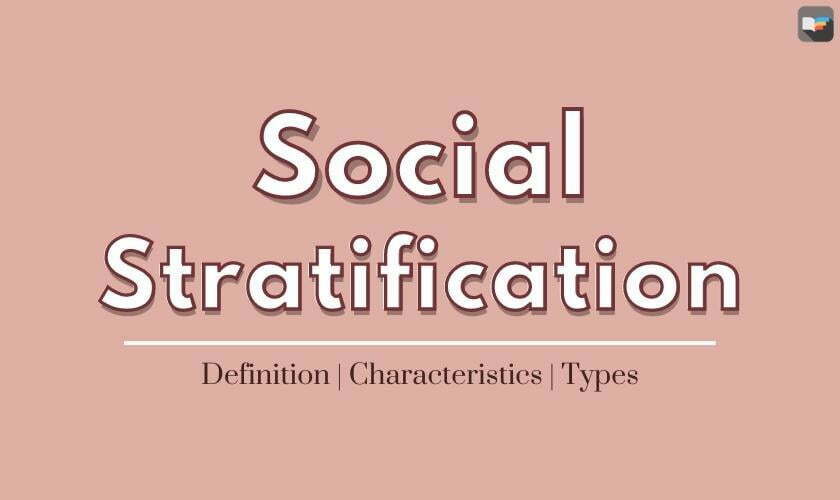Human society is not homogenous but heterogeneous. It is stratified everywhere in many respects such as economic, religious, political, moral, philosophical, etc. all societies arrange their member in terms of superiority, inferiority, and equality. The vertical scale of evaluation, this placing of people in strata or layers is called stratification. Thus social stratification is meant by the division of man into high and low levels of society.
There is no existence of such a society in the world where there is no difference or dissimilarities between a man with another man. Each man in the community falls into various classes; such as someone from economic, some educational, and some from a power point of view. This process is known as social stratification.
Define Social Stratification
Stratification is simply a process of interaction of differentiation whereby some people come to rank higher than others.

According to Raymond W. Murray, “Social stratification is a horizontal division of society into ‘high’ and ‘lower’ social units.”
According to Ogburn and Nimkoff, “The process by which individuals and groups are ranked in a more or less enduring hierarchy of status is known as stratification.”
Accordion to Sorokin, “Social stratification means the division of people by stages that means at one end in the society there exists the higher class and at the other end the lower class.”
According to Gisbert, “Social stratification is the division of society into permanent groups of categories linked with each other by the ration ship of superiority and subordination.”
From the above discussion, it can be said that social stratification is the unequal existence of individuals or groups in society. At one end is the higher class and at the other end is the lower class.
Characteristics of Social Stratification
Down below are the characteristics of social stratification in sociology:
- It is social: Stratification is social in the sense; it does represent biologically used inequalities. Indeed, such factors as strength, intelligence, age, and sex can often serve as the basis on which statuses or strata are distinguished.
- It is ancient: The stratification system is quite old. According to historical records; stratification was present even in the small wandering bands.
- It is universal: The stratification system is a worldwide phenomenon. The difference between the rich and the poor or the ‘haves’ and the ‘have nots’ is evident everywhere. Even in ‘non-literate’ societies, stratification is very much present.
- It is in diverse forms: The stratification system has never been uniform in all societies. Ancient Roman society was stratified into two strata; the patricians and the plebians.
- It is consequential: The stratification system is consequential and has its consequences. The most important, most desired, and often the scarcest things in human life are distributed unequally because of stratification.
Types of Social Stratification

The four main types of social stratification are given below:
- Slavery: Slavery is one of the elements of social stratification. A slave is considered the property of others by the law and customs of society. The characteristics of slavery are:
a. A slave was known as the property of his master. The master of the slave could use him any way he likes.
b. The slaves were hated in society.
c. The slave had no political rights. They were looked down upon in society.
d. The slave had to do compulsory labor slavery system was in vogue in ancient Greece and Rome. - Estate system: Estate system sometimes means property, sometimes social class, and sometimes rights and duties. In the middle age, there were three characteristics of the estate system. They were
a. The first state was the clergymen. They were called the first-class estate.
b. The second-class estate was aristocratic. The third class estate was the common people. The rights of the second-class estate were fixed by law and in the eye of the law, everybody is equal.
c. The people of first and second-class estates enjoyed social and political rights. - Social class: The social class is the part of a community that is separated from another part of the cause of social states. Generally, the people of the society are divided into three classes from three angles-
a. Economic
b. Power
c. Status to money
In respect of money, power, and status, the people of a society are divided into three classes.
a. Upper-class
b. Middle-class
c. Lower class
One class is separated from the other in respect of income, living conditions, honor, authority, etc. - Caste system: D.N. Majumder and T.N. Madan say that the caste system is a closed class. When a class is judged from the side of heredity, it is called a caste system. In the caste system membership is determined by birth and the social system is also predetermined. Besides in this system, the people of one caste cannot marry another caste. The caste system is one of the characteristics of Hindu society. According to the caste system, the Hindus are divided into four divisions. Such as
a. Brahmin
b. Kshatriya
c. Vaishya
d. Sudra.
At last, social stratification is a system of reviewing the different classes in society.
